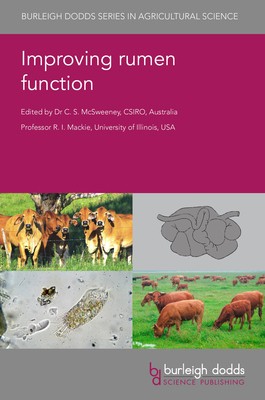
- We will send in 10–14 business days.
- Publisher: Burleigh Dodds Science Publishing Ltd
- ISBN-10: 178676332X
- ISBN-13: 9781786763327
- Format: 15.2 x 22.9 x 4.6 cm, kieti viršeliai
- Language: English
- SAVE -10% with code: EXTRA
Improving Rumen Function (e-book) (used book) | bookbook.eu
Reviews
Description
Major advances in analytical techniques and genomics have transformed our understanding of rumen microbiology. This understanding is of critical importance to livestock production since rumen function affects nutritional efficiency, emissions from ruminants (such as methane and nitrous oxide) as well as animal health. This collection reviews what we know about rumen microbiota and the role of nutritional strategies in optimising their function for more sustainable livestock production.
Part 1 summarises advances in understanding colonisation by rumen microbiota as well as advanced methods for analysing the rumen microbiome. Part 2 reviews recent research on the role of different types of rumen microbiota such as archea, anaerobic fungi, viruses and the rumen wall microbial community. Part 3 discusses the way the rumen processes nutrients such as fibre and protein as well as outputs such as energy, lipids and methane emissions. Part 4 explores nutritional strategies to optimise rumen function, including the role of pasture, silage, cereal feed, plant secondary compounds and probiotics.
EXTRA 10 % discount with code: EXTRA
The promotion ends in 21d.22:39:57
The discount code is valid when purchasing from 10 €. Discounts do not stack.
- Publisher: Burleigh Dodds Science Publishing Ltd
- ISBN-10: 178676332X
- ISBN-13: 9781786763327
- Format: 15.2 x 22.9 x 4.6 cm, kieti viršeliai
- Language: English English
Major advances in analytical techniques and genomics have transformed our understanding of rumen microbiology. This understanding is of critical importance to livestock production since rumen function affects nutritional efficiency, emissions from ruminants (such as methane and nitrous oxide) as well as animal health. This collection reviews what we know about rumen microbiota and the role of nutritional strategies in optimising their function for more sustainable livestock production.
Part 1 summarises advances in understanding colonisation by rumen microbiota as well as advanced methods for analysing the rumen microbiome. Part 2 reviews recent research on the role of different types of rumen microbiota such as archea, anaerobic fungi, viruses and the rumen wall microbial community. Part 3 discusses the way the rumen processes nutrients such as fibre and protein as well as outputs such as energy, lipids and methane emissions. Part 4 explores nutritional strategies to optimise rumen function, including the role of pasture, silage, cereal feed, plant secondary compounds and probiotics.


Reviews